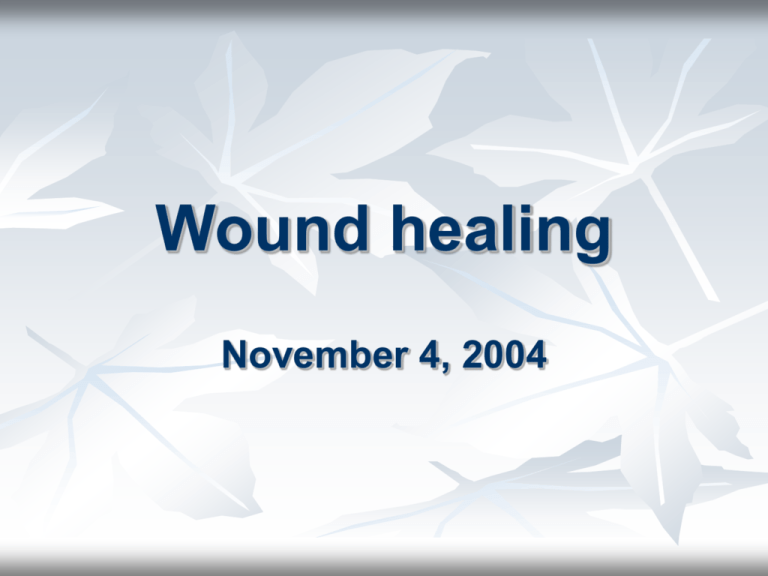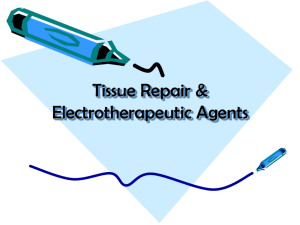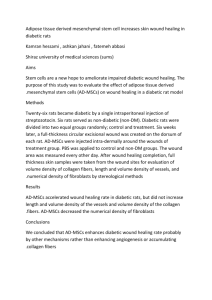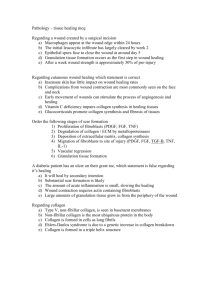ppt
advertisement

Wound healing November 4, 2004 Wound healing Wound healing is the process of repair that follows injury to the skin and other soft tissues. Healing is the interaction of a complex cascade of cellular events that generates resurfacing, reconstitution, and restoration of the tensile strength of injured tissue. Under the most ideal circumstances, healing is a systematic process, traditionally explained in terms of 3 classic phases: inflammation, proliferation, and maturation. Wound healing The inflammatory phase: a clot forms and cells of inflammation debride injured tissue. The proliferative phase: epithelialization, fibroplasia, and angiogenesis occur; additionally, granulation tissue forms and the wound begins to contract. The maturation phase: Collagen forms tight cross-links to other collagen and with protein molecules, increasing the tensile strength of the scar. I. Inflammatory Phase Immediate to 2-5 days B Hemostasis Vasoconstriction Platelet aggregation Thromboplastin makes clot C Inflammation Vasodilation Phagocytosis II. Proliferative Phase 2 days to 3 weeks B) Granulation Fibroblasts lay bed of collagen Fills defect and produces new capillaries C) Contraction Wound edges pull together to reduce defect D) Epithelialization Crosses moist surface Cell travel about 3 cm from point of origin in all directions III. Remodeling (maturation) Phase 3 weeks to 2 years B) New collagen forms which increases tensile strength to wounds. Scar tissue is only 80 percent as strong as original tissue Scar Formation The process of wound healing is essentially similar in all tissues and is relatively independent of the mode of injury; however, slight variation in the relative contribution of the different elements to the overall result may occur. The final product of the healing process is a scar. This relatively avascular and acellular mass of collagen serves to restore tissue continuity, strength and function. Delays in the healing process cause the prolonged presence of wounds, while abnormalities of the healing process may lead to abnormal scar formation. Inflammatory Phase The body responds quickly to any disruption of the skin’s surface. The early events of wound healing are characterized by a vascular and cellular response to injury. An incision made through a full thickness of skin causes a disruption of the microvasculature and immediate hemorrhage. Within seconds of the injury, blood vessels constrict to control bleeding at the site. Platelets coalesce within minutes to stop the bleeding and begin clot formation. Inflammatory phase Following incision of the skin, a 5- to 10minute period of vasoconstriction ensues, mediated by epinephrine, norepinephrine, prostaglandins, serotonin, and thromboxane. Vasoconstriction causes temporary blanching of the wound and functions to reduce hemorrhage immediately following tissue injury, aid in platelet aggregation, and keep healing factors within the wound. Inflammatory phase Endothelial cells retract to expose the subendothelial collagen surfaces; platelets attach to these surfaces. Adherence to exposed collagen surfaces and to other platelets occurs through adhesive glycoproteins: fibrinogen, fibronectin, thrombospondin, and von Willebrand factor. Inflammatory Phase Platelets also release factors that attract other important cells to the injury. Neutrophils enter the wound to fight infection and to attract macrophages. Macrophages break down necrotic debris and activate the fibroblast response. The inflammatory phase lasts about 24 hours and leads to the proliferation phase of the healing process. Inflammatory phase The aggregation of platelets results in the formation of the primary platelet plug. Aggregation and attachment to exposed collagen surfaces activates the platelets. Activation enables platelets to degranulate and release chemotactic and growth factors, such as platelet-derived growth factor (PDGF), proteases, and vasoactive agents (eg, serotonin, histamine). Stages in platelet plug formation Inflammatory phase The coagulation cascade occurs by 2 different pathways. The intrinsic pathway begins with the activation of factor XII (Hageman factor), when blood is exposed to extravascular surfaces. The extrinsic coagulation pathway occurs through the activation of tissue factor found in extravascular cells in the presence of factors VII and VIIa. Inflammatory phase Both pathways proceed to the activation of thrombin, which converts fibrinogen to fibrin. The fibrin product is essential to wound healing and is the primary component of the wound matrix into which inflammatory cells, platelets, and plasma proteins migrate. Removal of the fibrin matrix impedes wound healing. Inflammatory phase In addition to activation of fibrin, thrombin facilitates migration of inflammatory cells to the site of injury by increasing vascular permeability. By this mechanism, factors and cells necessary to healing flow from the intravascular space and into the extravascular space. Inflammatory phase The result of platelet aggregation and the coagulation cascade is clot formation. Clot formation is limited in duration and to the site of injury. Clot formation dissipates as its stimuli dissipate. Plasminogen is converted to plasmin, a potent enzyme aiding in cell lysis. Clot formation is limited to the site of injury because uninjured nearby endothelial cells produce prostacyclin, an inhibitor of platelet aggregation. In the uninjured nearby areas, antithrombin III binds thrombin, and protein C binds factors of the coagulation cascade, namely, factors V and VIII. Proliferation Phase On the surface of the wound, epidermal cells burst into mitotic activity within 24 to 72 hours. These cells begin their migration across the surface of the wound. Fibroblasts proliferate in the deeper parts of the wound. These fibroblasts begin to synthesize small amounts of collagen which acts as a scaffold for migration and further fibroblast proliferation. Proliferation Phase Granulation tissue, which consists of capillary loops supported in this developing collagen matrix, also appears in the deeper layers of the wound. The proliferation phase lasts from 24 to 72 hours and leads to the fibroblastic phase of wound healing. Proliferation Phase Four to five days after the injury occurs, fibroblasts begin producing large amounts of collagen and proteoglycans. Collagen fibers are laid down randomly and are cross-linked into large, closely packed bundles. Proliferation Phase Proteoglycans appear to enhance the formation of collagen fibers, but their exact role is not completely understood. Within two to three weeks, the wound can resist normal stresses, but wound strength continues to build for several months. The fibroblastic phase lasts from 15 to 20 days and then wound healing enters the maturation phase. Maturation Phase During the maturation phase, fibroblasts leave the wound and collagen is remodeled into a more organized matrix. Tensile strength increases for up to one year following the injury. While healed wounds never regain the full strength of uninjured skin, they can regain up to 70 to 80% of its original strength.




